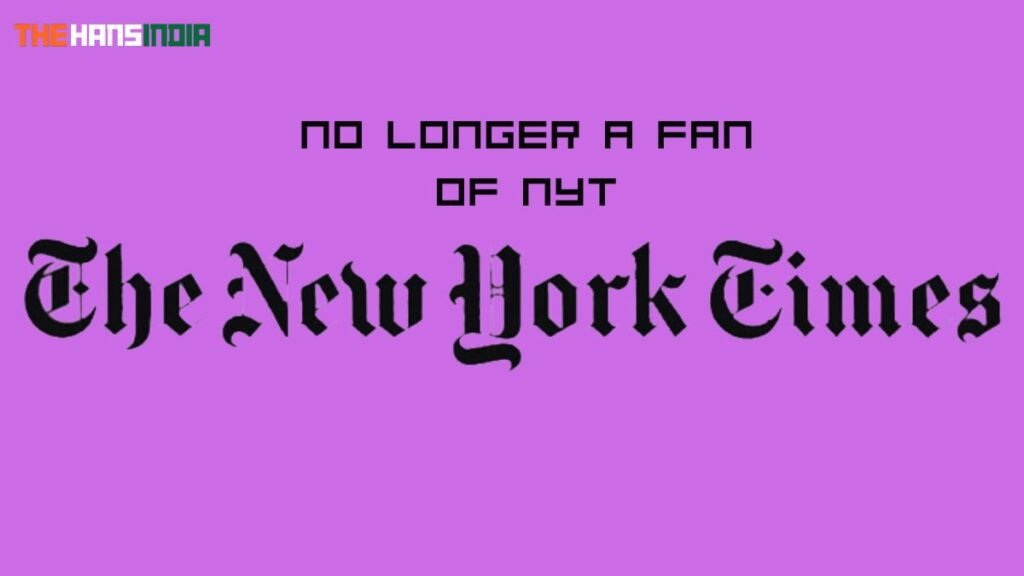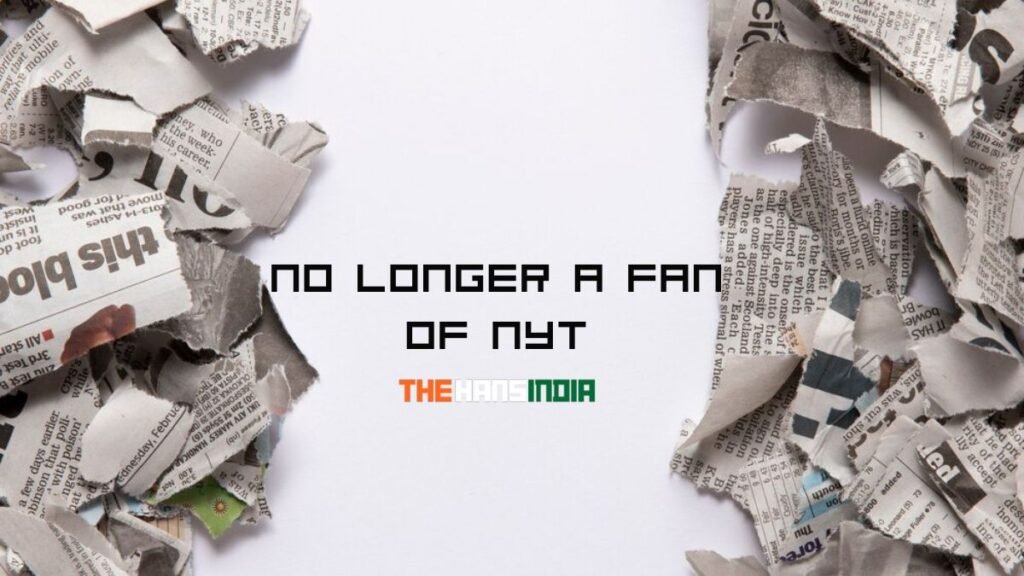Introduction
The New York Times, often regarded as the “newspaper of record,” has long been a beacon of journalistic excellence. Its reputation for delivering in-depth analysis, investigative reporting, and diverse perspectives has made it a staple for readers worldwide. However, in recent years, my relationship with The New York Times has taken a significant turn. What once felt like a reliable source of information now feels increasingly flawed and disconnected from its original mission. In this article, I’ll explore why I’m no longer a fan of NYT The New York Times, highlighting the key changes that have fueled my disillusionment.
The Decline of Journalistic Integrity
A Shift in Editorial Standards
One of the primary reasons I’ve no longer a fan of nyt The New York Times is the noticeable decline in its journalistic integrity. The newspaper, which once adhered to the highest editorial standards, now seems more focused on generating clicks than providing well-researched, unbiased news. Sensationalism has taken precedence over substance, and the line between news and opinion has become increasingly blurred.
Impact of Clickbait Headlines
In an era where online traffic is king, NYT The New York Times has not been immune to the lure of clickbait headlines. These headlines are often misleading, designed to provoke an emotional response rather than inform. As a result, readers are frequently left with a skewed understanding of the issues at hand. This shift towards sensationalism undermines the trust that readers once placed in the newspaper.
Increased Bias and Partisanship
Erosion of Objectivity
Another critical issue is the growing bias and partisanship that permeates The New York Times. Once a bastion of balanced reporting, the paper now seems more aligned with a particular political ideology. This erosion of objectivity is evident in the way stories are framed, the selection of sources, and even the topics that are chosen for coverage. Readers seeking a fair and balanced view of the news are often left wanting.
The Influence of Social Media and Echo Chambers
Social media has played a significant role in shaping public discourse, and The New York Times has not been immune to its influence. In an effort to cater to its online audience, the newspaper appears to have embraced the echo chamber effect, where only certain viewpoints are amplified, and dissenting opinions are marginalized. This trend towards ideological homogeneity is troubling and contributes to the polarization of public opinion.
The Marginalization of Diverse Voices
Lack of Representation
No longer a fan of nyt The New York Times has long been criticized for its lack of diversity in both its newsroom and its coverage. While the paper has made efforts to address this issue, there is still a long way to go. The perspectives of marginalized communities are often overlooked or underrepresented, leading to a narrow and incomplete picture of the world. This lack of representation is another factor that has contributed to my waning support for the newspaper.
Tokenism and Performative Activism
In response to criticism, The New York Times has attempted to incorporate more diverse voices, but these efforts often come across as tokenistic or performative. Rather than genuinely engaging with different perspectives, the paper seems more interested in checking boxes to appease critics. This superficial approach fails to address the underlying issues and does little to rebuild trust with its readership.
The Commercialization of Content
Native Advertising and Sponsored Content

The line between journalism and advertising has become increasingly blurred at The New York Times. Native advertising and sponsored content are now common, often indistinguishable from traditional reporting. This commercialization of content raises ethical concerns and calls into question the newspaper’s commitment to providing unbiased information. Readers deserve to know when they are being marketed to, and this lack of transparency is troubling.
Subscription Model and Paywalls
The New York Times’ subscription model, while necessary for its financial sustainability, has also contributed to my growing disillusionment. The introduction of paywalls has limited access to information, creating a divide between those who can afford to pay for news and those who cannot. This approach not only restricts access to vital information but also undermines the principle of a free press.
The Handling of Controversial Issues
Inconsistent Coverage
The New York Times’ handling of controversial issues has been another source of frustration. The newspaper’s coverage often lacks consistency, with some topics receiving extensive attention while others are glossed over or ignored altogether. This selective reporting raises questions about the newspaper’s priorities and whether certain issues are being deliberately downplayed.
Failure to Hold Power to Account
One of the most disappointing aspects of no longer a fan of nyt The New York Times’ recent trajectory is its failure to hold those in power accountable. Investigative journalism, once a hallmark of the newspaper, has taken a backseat to more sensational stories. This shift away from rigorous scrutiny of those in power is a disservice to readers and a betrayal of the newspaper’s mission.
The Decline in Investigative Journalism
Focus on Short-Form Content
In the digital age, attention spans are shorter, and The New York Times has adapted by focusing more on short-form content. While this approach may attract clicks, it has come at the expense of in-depth investigative journalism. The long-form, deeply researched pieces that once set the newspaper apart are becoming increasingly rare, leaving readers with a less comprehensive understanding of complex issues.
The Impact of Budget Cuts
Budget cuts and newsroom layoffs have also taken a toll on The New York Times’ ability to produce high-quality investigative journalism. With fewer resources at their disposal, reporters are often stretched thin, unable to dedicate the time and effort required for thorough investigations. This decline in investigative reporting is yet another reason why I’m no longer a fan of NYT The New York Times.
The Role of The New York Times in Shaping Public Discourse
Amplification of Certain Narratives

The New York Times plays a significant role in shaping public discourse, and its influence cannot be overstated. However, the newspaper’s tendency to amplify certain narratives while ignoring others has contributed to a skewed understanding of the issues facing society. By giving disproportionate attention to some topics and neglecting others, The New York Times is shaping public opinion in ways that may not always be in the best interest of its readers.
The Consequences of Agenda-Driven Reporting
When a newspaper as influential as no longer a fan of nyt The New York Times adopts an agenda-driven approach to reporting, the consequences can be far-reaching. This type of reporting can contribute to the polarization of society, as readers are exposed to a narrow range of perspectives. The newspaper’s responsibility to provide balanced, unbiased reporting is more important than ever, but it is a responsibility that The New York Times seems to be neglecting.
Conclusion
I am no longer a fan of NYT, The New York Times has long been a cornerstone of American journalism, but recent years have seen a troubling shift in its editorial approach. The decline in journalistic integrity, increased bias, marginalization of diverse voices, and the commercialization of content have all contributed to my growing disillusionment. While The New York Times remains an influential institution, it is no longer the beacon of unbiased, in-depth reporting that it once was. For readers like myself, this shift has led to a search for alternative sources of news that better align with the principles of good journalism. It is my hope that The New York Times will take these concerns seriously and work towards restoring the trust of its readership.
FAQs
Is The New York Times still a reliable source of news?
While The New York Times continues to produce valuable journalism, concerns about bias, sensationalism, and the decline in investigative reporting have led some readers, including myself, to question its reliability. It’s important to approach any news source critically and consider multiple perspectives.
What alternatives are there to The New York Times?
There are several alternative news sources that provide high-quality journalism, including The Washington Post, The Guardian, and independent outlets like ProPublica. It’s beneficial to diversify your news consumption to get a well-rounded view of current events.
How has The New York Times responded to criticism?
The New York Times has acknowledged some criticisms and has made efforts to address issues like diversity and transparency. However, many readers feel that these efforts have been insufficient or performative, and significant challenges remain.
Why has The New York Times become more biased?
The shift towards bias in The New York Times may be influenced by several factors, including the pressures of maintaining online readership, the influence of social media, and the changing landscape of journalism. As the media environment evolves, so too does the editorial approach of major outlets like The New York Times.
Is The New York Times still relevant today?
Despite its flaws, The New York Times remains a major player in the media landscape and continues to influence public discourse. However, its relevance depends on its ability to adapt to the challenges it faces and restore the trust of its readers.
Can The New York Times regain its former glory?
Rebuilding trust will require The New York Times to recommit to its core principles of unbiased reporting, diversity of perspectives, and in-depth journalism. While it’s possible for the newspaper to regain its former stature, it will take concerted effort and a willingness to make meaningful changes.


